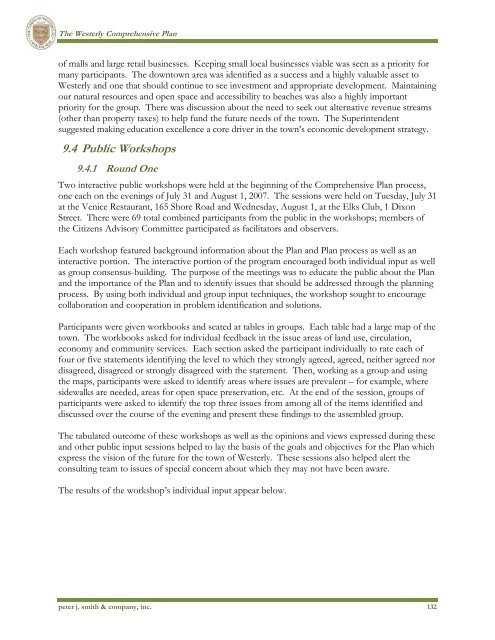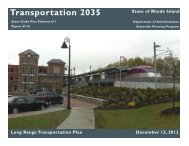Westerly - State of Rhode Island: Division of Planning
Westerly - State of Rhode Island: Division of Planning
Westerly - State of Rhode Island: Division of Planning
You also want an ePaper? Increase the reach of your titles
YUMPU automatically turns print PDFs into web optimized ePapers that Google loves.
The <strong>Westerly</strong> Comprehensive Plan<strong>of</strong> malls and large retail businesses. Keeping small local businesses viable was seen as a priority formany participants. The downtown area was identified as a success and a highly valuable asset to<strong>Westerly</strong> and one that should continue to see investment and appropriate development. Maintainingour natural resources and open space and accessibility to beaches was also a highly importantpriority for the group. There was discussion about the need to seek out alternative revenue streams(other than property taxes) to help fund the future needs <strong>of</strong> the town. The Superintendentsuggested making education excellence a core driver in the town’s economic development strategy.9.4 Public Workshops9.4.1 Round OneTwo interactive public workshops were held at the beginning <strong>of</strong> the Comprehensive Plan process,one each on the evenings <strong>of</strong> July 31 and August 1, 2007. The sessions were held on Tuesday, July 31at the Venice Restaurant, 165 Shore Road and Wednesday, August 1, at the Elks Club, 1 DixonStreet. There were 69 total combined participants from the public in the workshops; members <strong>of</strong>the Citizens Advisory Committee participated as facilitators and observers.Each workshop featured background information about the Plan and Plan process as well as aninteractive portion. The interactive portion <strong>of</strong> the program encouraged both individual input as wellas group consensus-building. The purpose <strong>of</strong> the meetings was to educate the public about the Planand the importance <strong>of</strong> the Plan and to identify issues that should be addressed through the planningprocess. By using both individual and group input techniques, the workshop sought to encouragecollaboration and cooperation in problem identification and solutions.Participants were given workbooks and seated at tables in groups. Each table had a large map <strong>of</strong> thetown. The workbooks asked for individual feedback in the issue areas <strong>of</strong> land use, circulation,economy and community services. Each section asked the participant individually to rate each <strong>of</strong>four or five statements identifying the level to which they strongly agreed, agreed, neither agreed nordisagreed, disagreed or strongly disagreed with the statement. Then, working as a group and usingthe maps, participants were asked to identify areas where issues are prevalent – for example, wheresidewalks are needed, areas for open space preservation, etc. At the end <strong>of</strong> the session, groups <strong>of</strong>participants were asked to identify the top three issues from among all <strong>of</strong> the items identified anddiscussed over the course <strong>of</strong> the evening and present these findings to the assembled group.The tabulated outcome <strong>of</strong> these workshops as well as the opinions and views expressed during theseand other public input sessions helped to lay the basis <strong>of</strong> the goals and objectives for the Plan whichexpress the vision <strong>of</strong> the future for the town <strong>of</strong> <strong>Westerly</strong>. These sessions also helped alert theconsulting team to issues <strong>of</strong> special concern about which they may not have been aware.The results <strong>of</strong> the workshop’s individual input appear below.peter j. smith & company, inc. 132
















